lördag 15 november 2008
The views of Himalaya, Part I
Walking in the Himalayas is like being part of a movie like The Lord of the rings or The Brothers Lionheart. There are breathtaking views around every cliff and cottagecorner. Mt Everest is fantastic, but so is Amadablam, the mountain which looks like a sugarcane.




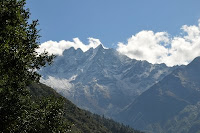
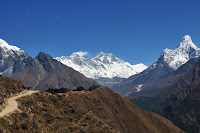




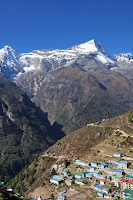



fredag 14 november 2008
The Poilâne bakery
 There is a bakery in France called The Poilâne bakery. It has a long and interesting history - starting in 1932 when a young baker opened his first shop in Paris.
There is a bakery in France called The Poilâne bakery. It has a long and interesting history - starting in 1932 when a young baker opened his first shop in Paris.One of the most fascinating things about the bakery, is that they use a piece of dough from the previous batch of bread – the sourdough – as a starter for the next batch. In that way, every piece of bread has a connection to the history of the bakery. What a great idea!
 Branding: History, passion, assortment, breadclub, ingredients, shops, cooking classes, production techniques, "retro-innovation", wood-fired ovens.
Branding: History, passion, assortment, breadclub, ingredients, shops, cooking classes, production techniques, "retro-innovation", wood-fired ovens.www.poilane.fr
torsdag 13 november 2008
Vinter, the restaurant
I have a new favorite-restaurant. It is called Vinter and serves food with a touch of northern Sweden. The food is great, the staff very friendly and the atmosphere relaxing, creative and home-like.
I was there with some friends last night. Everybody was happy with the food and the evening. We could talk easily without being drowned by loud music. It´s a small place - probably one of the reasons why it feels almost like visiting a friend at home.
www.restaurangvinter.se
Restaurang Vinter, Tomtebogatan 22, Stockholm, tfn 08-33 24 54
Branding: the menu, service, ethnic touch, interior, creativity, silent enthusiasm, atmosphere, theme and variations.
I was there with some friends last night. Everybody was happy with the food and the evening. We could talk easily without being drowned by loud music. It´s a small place - probably one of the reasons why it feels almost like visiting a friend at home.
www.restaurangvinter.se
Restaurang Vinter, Tomtebogatan 22, Stockholm, tfn 08-33 24 54
Branding: the menu, service, ethnic touch, interior, creativity, silent enthusiasm, atmosphere, theme and variations.
onsdag 12 november 2008
Personal branding from the inside
Many people might think of personal branding as the exterior of a person - clothing, gestures, use of language, network.... Well, that is one part of it. However we need to start with the interior if we want to create an interesting exterior and be happy about it.
Today I read in the local paper about people who travel to their jobs in alternative ways: by cayak, by a "lay-down-bike" and by running for two hours while training for marathons. When these people arrive at work they have already had some quality time. They will perform better since they got some workout on the way. And - although they might not have planned it - they build their personal brands as being creative, proactive and outstanding.
Personal branding can be very shallow. It can also be a way of living, to focus on goals and to reach them in effective ways. We choose.

Today I read in the local paper about people who travel to their jobs in alternative ways: by cayak, by a "lay-down-bike" and by running for two hours while training for marathons. When these people arrive at work they have already had some quality time. They will perform better since they got some workout on the way. And - although they might not have planned it - they build their personal brands as being creative, proactive and outstanding.
Personal branding can be very shallow. It can also be a way of living, to focus on goals and to reach them in effective ways. We choose.

Taking risks
There are a couple of ways to reach the starting point for a trekk to Basecamp Everest or Kala Pathar. You can take a bus from Kathmandu to Jiri and then walk all the way to Lukla, which takes an extra week on a rollercoaster trail. You can also - as most people do - take the plane directly from Kathmandu to Lukla, and start walking from there.
We had decided to fly to Lukla. The week before our arrival, a plane crashed on the runway. For some reason, the plane got stuck in some kind of fence on the side of the runway. Everybody on the plane died. It was tragic.
Considering the characteristics of the runway in Lukla, one might be surprised that accidents hardly ever happen... The runway is leaning on the mountainside, starting with the rock face and ending with a steep precipice dropping 700 m to the valley down below. The runway is 527 m long from start to end, leaning 12 %. Helicopters and Twin Otters operate here. To start and land in Lukla, you need to operate with great perfection.
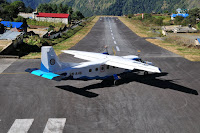




Wind and weather cause plenty of delays here. Usually the planes can start and land during the morning hours. If it is foggy, you must wait for your departure until the next day, or the day after or...
"The only thing we have to fear is fear itself."
Franklin D. Roosevelt
We had decided to fly to Lukla. The week before our arrival, a plane crashed on the runway. For some reason, the plane got stuck in some kind of fence on the side of the runway. Everybody on the plane died. It was tragic.
Considering the characteristics of the runway in Lukla, one might be surprised that accidents hardly ever happen... The runway is leaning on the mountainside, starting with the rock face and ending with a steep precipice dropping 700 m to the valley down below. The runway is 527 m long from start to end, leaning 12 %. Helicopters and Twin Otters operate here. To start and land in Lukla, you need to operate with great perfection.
Wind and weather cause plenty of delays here. Usually the planes can start and land during the morning hours. If it is foggy, you must wait for your departure until the next day, or the day after or...
"The only thing we have to fear is fear itself."
Franklin D. Roosevelt
tisdag 11 november 2008
The children of Himalaya
The children of Himalaya may live tough lives in some aspects. It can be very cold. The variety in food may not be the best - although most of the children seem to be healthy. The standard of living is quite low. There are a few dangers around - steep mountainsides, rivers, big yaks to stay away from...
But imagine living in those beautiful surroundings, getting inspiration from people from all over the world daily, making up new playing-games from whatever you can find, growing creativity...
When we took pictures of the children and showed them, they were always fascinated, giggled and wanted too see more.







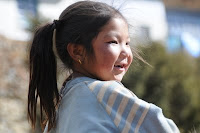



But imagine living in those beautiful surroundings, getting inspiration from people from all over the world daily, making up new playing-games from whatever you can find, growing creativity...
When we took pictures of the children and showed them, they were always fascinated, giggled and wanted too see more.
The porters of Himalaya
Sherpa, Sirdar, porters and yaks
To follow through a trekk in the Himalayas, you may need some help. First of all, there are porters. They carry most of your luggage. It is amazing to see their determination as they move steadily upwards with 40, 50, 60 kg on their back and head. We may think that it is a lack of respect to have someone else do most of the carrying. However, it is a source of income and a part of the culture in the mountains.
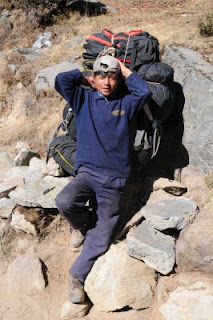
For heavier loads, there are yaks and djoppios (yak and cow mixed - they are more comfortable on lower altitude than yaks) who act as moving roadblocks as they sway along the trail - sometimes in long caravans. To avoid being pushed off the trail by a swaying yak you need to meet them on the mountainside of the trail, watching out for those long and sharp antlers.

Sherpa is a name for both a group of people in Nepal and the task of walking in front and finding the best trail for the group. Our sherpa Kamal used to be a porter. Now he has advanced into the role of a very serviceminded and appreciated sherpa.


Sirdar - or sardar - is the chief of sherpas and porters. He takes care of the logistics and walks at the end of the group to make sure that everyone is on track. Our sirdar Pemba was fantastic. His smile could melt all the glaciers of Himalaya. What a guy!
For heavier loads, there are yaks and djoppios (yak and cow mixed - they are more comfortable on lower altitude than yaks) who act as moving roadblocks as they sway along the trail - sometimes in long caravans. To avoid being pushed off the trail by a swaying yak you need to meet them on the mountainside of the trail, watching out for those long and sharp antlers.
Sherpa is a name for both a group of people in Nepal and the task of walking in front and finding the best trail for the group. Our sherpa Kamal used to be a porter. Now he has advanced into the role of a very serviceminded and appreciated sherpa.
Sirdar - or sardar - is the chief of sherpas and porters. He takes care of the logistics and walks at the end of the group to make sure that everyone is on track. Our sirdar Pemba was fantastic. His smile could melt all the glaciers of Himalaya. What a guy!
Prenumerera på:
Inlägg (Atom)
